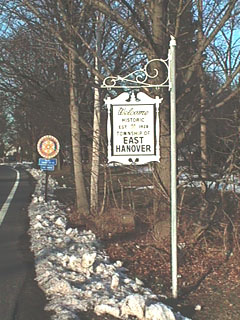
A Brief History of East Hanover

Prehistoric East Hanover
During the Ice Age, land in northern New Jersey that now includes East Hanover was shaped by glaciers moving across the land. During this time, the glaciers formed valleys, riverbeds, and mountains. Shortly afterward, the area was submerged under pre-historic Lake Passaic. The underground body of water that exists beneath East Hanover today is a reminder of this history.
Native Americans in New Jersey
The first settlers of the land where East Hanover now stands were the Lenni Lenape Indians. Meaning "original people," the Lenni Lenape were divided into three sub-tribes that occupied the length of what we now know as New Jersey.
The Unami, meaning the people down the river, occupied the land now known as East Hanover. Attracted by the excellent source of water, the abundant animal life, and the advantageous location between the Delaware and Hudson River settlements of Indians. Other sub-tribes were the Minsi, who occupied areas farther north than East Hanover, and the Unalachtigo, who occupied areas farther south.
Europeans in East Hanover
The Unami’s dominance in the area was disturbed when the Europeans landed in their "New World" in the late 1600s. However, this New World was nothing new to the Unami, who interacted peacefully with the Europeans.
Though they did not believe in or understand the idea of owning land, the Unami agreed to surrender their rights to the area including East Hanover. On August 13, 1708, several thousand acres were sold by Unami for 30 pounds (cash), 10 strands of water blankets, 15 kettles, 20 axes, 20 hoes, 10 duffel blankets, a half barrel of wine, 1 barrel of rum, 1 barrel of cyder. 3 files, 1 gun boer, 1 auger, 4 pistols, 4 cutlasses, 10 guns, 100 bars of lead, 1/2 barrel of powder, 10 white blankets, 20 shirts, and 100 knives.
Hanover Township
The name Hanover came from the House of Hannover in Germany. This namesake was given to the Township of Hanover (which included present-day East Hanover) on December 7, 1720 as a sign of respect to King George I of the House of Hannover, a British king who ruled over the American colonies in the eighteenth century.
Unique among towns, East Hanover is defined by the joining of two rivers, the Whippany to the west and north and the Passaic to the east and north. This geographic effect led to the early name of East Hanover, "Hanover Neck."
Since the creation of Hanover Township in 1720, its size has been considerably decreased as the population of the area has increased. Originally encompassing Morris County and parts of Sussex and Warren County, Hanover Township became too unwieldy for a single local government as time passed. The members of the government felt that Hanover Township needed to break apart into smaller towns that could provide more responsive local control, even if it meant increased taxes to support new facilities for each.
Population of Hanover Township
| Date | Population |
| 1810 | 3,843 |
| 1830 | 3,718 |
| 1850 | 3,608 |
| 1870 | 3,624 |
| 1890 | 5,366 |
| 1910 | 6,228 |
| 1930 | 2,516 |
East Hanover Township
The Township of East Hanover was formed from Hanover Township on May 9, 1928. As seen in the chart above, the fragmentation of Hanover Township between 1910 and 1930 was due in major part to the formation of smaller townships such as the Township of East Hanover.
East Hanover’s population has just recently blossomed over 10,000, a tremendous growth from 946 in 1930, soon after the creation of the township.